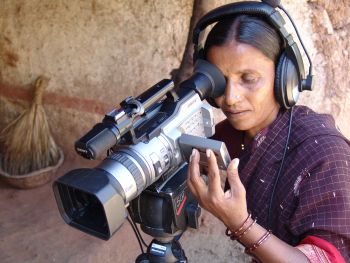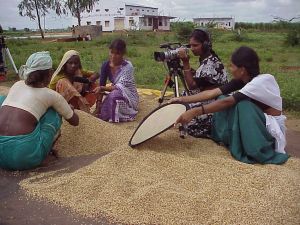We dont know how to read and write but we know how to make films. As we learned to tend to our farms, we have now learnt to make videos. The camera is the new sickle in our hands. Chinna Narasamma, Humnapur Laxmamma, Musligari Kavita, Edakulapalli Narasamma and Begari Mollamma represented the Community Media Trust at the Bangalore launch of their publication Affirming Life and Diversity held on 18 June.
Addressing a mixed gathering of media students, social activists, members from womens groups, filmmakers, media persons, agricultural scientists, anthropologists, development communication specialists and others, Laxmamma said, We are trying to raise your awareness of our issues.

![]() Ippapalle Mollamma of the Community Media Trust. Pic: CMT.
Ippapalle Mollamma of the Community Media Trust. Pic: CMT.
The Community Media Trust (CMT), based in Pastapur, Medak district, Andhra Pradesh is an exemplary community of women farmers who have taken full charge of their lives and environment. They have now even learnt to record their own culture, their problems, their concerns on filmknowing that nobody from outside will come and do it. They do both filming and farming, wielding the camera and the mike with as much ease and expertise as the sickle and the plough.
The origins of the CMT can be traced to the Deccan Development Society (DDS), a two-decade-old grassroots organisation that facilitated the creation of sanghams or collectives of the poorest and marginalised women in about 75 villages in Medak district. These women worked to revive tradition crop systems of the village. Through their collective efforts, they revived fallow lands, gained control over land, seeds, soil, natural resources, food, health and markets. They were instrumental in creating a bounty of millet seeds that were then stored, used, distributed according to the needs of the community, thus becoming an alternate public distribution system for the community.
The DDS members grew from strength to strength. Gradually they realised the need for their own media to map their culture, record their triumphs and sort out their concerns. With trepidation, DDS sangham women responded to a couple of video workshops organised by DDS. But once they discovered their own technical and media skills, there was no stopping these women. The best students formed the Community Media Trust. The CMT was thus born out of the DDS, but is independent of it. The camera has now become an extension of their eyes and minds. The CMT has more than 75 films to its credit now.

•
Information as empowerment
•
Through the eyes of women filmmakers
As they work and stir up meaningful discourses on farming and filming, the filmmakers take turns baby-sitting. They prepare the soil for sowing. They prepare food for their families and the millet-food café they run. They attend Sangham and office meetings. They travel and shoot films commissioned to them. They campaign for agro-biodiversity. They manage their office accounts and maintain their equipment. They put away seeds in large, cane baskets lined with neem leaves for safe preservation.
The mike and camera have not replaced the sickle and plough in the rough hands of these filmmakers. They work easily with both sets of tools. They use both sets of tools to protect, nourish and enrich their community. Like they routinely coax out thick green shoots and an abundance of grain from the semi-arid soil in their region, they continuously record, discuss and debate on the concerns of their community, on camera. They actively reach out for change and improvement while treasuring timeworn, traditional methods.
After the Bangalore launch, Musligari Kavita described the important role that the Trust plays in the community. We live in a small village in Andhra Pradesh. We make films on agriculture, problems faced by single women, children who dont go to school, etc. They show big cars and big houses on TV ads. We cannot identify with that. We dont feel like we should go to the city and shoot films and advertisements. Our focus is not the city. What is there to report in a city? People die in accidents. Politics happens. People fight or kill. The city people wont care to come to our village and understand our festivals. We must film and package our festivals so others can know about them. We dont have a channel, so we make films.
Chinna Narasamma added, We make films about the Balwadis the playschools for children of farm labourers. Sometimes there are no rains and we make films on how people are coping. We show our films at monthly sangham meetings. According to the season and occasion, we choose the film. Every year we host a travelling biodiversity festival for a whole month after Sankranthi the harvest festival. We show one film every night for that whole month. People watch the films and relate to them.
The festival is a 10-year-old tradition - a celebratory, cultural campaign that builds awareness about multi-cropping. A colourful caravan of carts, decorated with pictures and charts, travels through the villages of Medak, camping at various locations and DDS sangham members conduct interactive programmes on relevant subjects.
The biggest impact of this festival at the national level is that it has influenced the National Biodiversity Action Plan. The discourses, initiated by the biodiversity festival, have been taken into consideration at the national level. At the local level, growing of millets, especially the minor millets, has doubled. The festival has given birth to a millet market of the people.

![]() CMT video group with a reflector. Pic: CMT.
CMT video group with a reflector. Pic: CMT.
Laxmamma said, We have risen in the eyes of the community after becoming filmmakers. When people see our photos in the newspapers, they come and tell us you have come in the paper. You have come on TV. We feel we have done something good for our people so we have come on TV.
The DDS CMT has won the prestigious UGC-CEC National Award for the Best Educational Video Film over hundreds of other filmmakers urban and rural. Their well-researched, sensitive films on Bt cotton (included in the just launched publication) played a key role in the campaign against Monsanto in India. The women went on to map the same issue at the international level by interacting with farmers in Indonesia, Thailand, Mali and South Africa.
P V Satheesh, director, DDS, said, The CMT members use video communication to talk among themselves, not to speak to anyone higher up or lower down. That is why their filming style is called horizontal communication. Later, when they extended their area of operation, they were still speaking to peasants, first in AP and later worldwide. The character of their communication still remains horizontal.
A group from Delhi made a film on the CMT and called it the Sangham Shot. The film was constructed with interviews of the CMT members and interspersed with footage shot by them. The film derived its name from a term used by the women as part of their own media terminology to describe the Eye Level Shot. For them, the Eye Level Shot is the most democratic. It is an equality shot taken from their own sanghams where everyone sits on the ground and looks at each other at eye level, said Satheesh.
Satheesh described how the CMT makes films, They first film the footage on any issue or theme, keeping a thin story line in mind. Post filming, they do a rough cut of the footage, to resemble the story they have had in mind. Since they cannot write, there is no written script that the edit follows. The theme is decided on after discussion and debate within the CMT team, if it is their own production. Else, they work on films commissioned to them by various agencies. According to Satheesh, They do storyboarding for short films but for longer films the script evolves out of the footage taken. They do the first edit of the footage. Later, they sit with one of the rural editors and shape and fine-tune the film.
The CMT is an independent media trust facilitated by DDS. Having started the process of handing over to the community six years after DDS started, Satheesh said, People like me are almost outsiders to DDS. Our role is to package what the community says and hand it back to them. Over two decades, DDS has become an organisation that is staffed by the community for the community. Five years ago, they introduced the practice of self appraisal wherein annual increments are based on the staffs own assessment of work done.
Commenting on the mainstream medias cursory response to the multi-city launch of the CMT publication, Satheesh shared that hardly one Indian newspaper tried to understand and appreciate the philosophy behind the work of these independent filmmakers. The media has been de-capacitated by the commerce and politics of the media itself. It has trapped itself and is going to call its own death or that of its audience by dumbing down to this extent. As media women rooted in their mileu, the CMT filmmakers have a perspective on the issues they cover, says the long time TV producer. It is a media of sense and quality, he adds.
The CMTs work reiterates that the media is after all a peoples tool for change and empowerment, a record of culture in transit and a means rather than an end. Their work proves that the best kind of journalism results when the motivation to inform and bring change is independent of the commercial agenda.
About the publication
Affirming Life and Diversity: Rural Images and Voices on Food Sovereignty in South India is a stylishly designed and produced multimedia publication created by non-literate, farmer filmmakers of the DDS CMT. It includes a collection of 12 vividly detailed video films made by Dalit, women filmmakers from the CMT.
The publication has seen a multi-city, international launch over May and June. It was globally launched in Bonn, Germany on 19 May as part of the United Nations Convention on Biodiversity. It was later launched in Canada and subsequently in various Indian cities.
About the films
The films describe the outcomes of participatory action research facilitated by DDS and the UK-based International Institute for Environment and Development (IIED - an international policy research institute and non governmental body working for more sustainable and equitable global development).
The action research - called Sustaining Local Food Systems, Agricultural Biodiversity and Livelihoods - consciously adopted a medium of documentation that could be simultaneously understood by non-literate partners and other audiences, including scientific researchers. This approach helped the filmmakers to produce a body of films on Dalit food systems, community food sovereignty, autonomous markets and autonomous media.
The 12 films are thematically classified and available on four DVDs titled Autonomy Over Food and Seed, Controlling Technology and Markets, A New Grassroots Globalism in Action and Grassroots Confront Genetic Engineering. The films are accompanied by an introductory booklet co-authored by P V Satheesh and Michel Pimbert, Director of Sustainable Agriculture, Biodiversity and Livelihoods Program at the IIED.
The vibrant films showcase how local womens collectives of marginalised farmers and urban food consumers are creating sustainable models of citizen controlled food systems. The films throw up a host of possibilities for farmers, media practitioners, policy makers, agricultural scientists and citizens trying to get their issues reflected in the media. They hold out many lessons to international researchers working towards eradicating extreme poverty and hunger while ensuring environmental sustainability.
The films are content-rich, self-assured, focused and culturally and socially rooted. The CMT filmmakers have used the medium of video not only to articulate their concerns but also to document their culture and campaign for sustainable, natural farming that is good for the earth and communities living on it.























